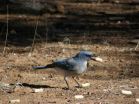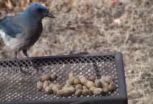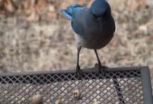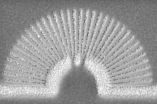Birds 'weigh' peanuts and choose heavier ones
2015-05-22
(Press-News.org) Many animals feed on seeds, acorns or nuts. The common feature of these are that they have shells and there is no direct way to know what's inside. How do the animals know how much and what quality of food is hidden inside? A simple solution would be to break the shells, which often takes time and effort -- it would be a big disappointment to know that it's rotten or bad after the hard effort of opening the nuts!
Can animals evaluate the food hidden inside the nuts? This is especially important for some animals who cache the food items for later use without opening and checking each item. We can detect which one is heavier by moving the items up and down several times and focusing on the "feeling of heaviness" we perceive. Humans can also detect the quality of a water melon by knocking on it.
A new study published in Journal of Ornithology suggests that some birds can also use similar tricks in choosing the peanuts from the feeder. Ther study was carried out in Arizona by an international research team from Poland and Korea and revealed that the Mexican Jays (Aphelocoma wollweberi) may be able to "weigh" peanuts and maybe even "listen to" peanuts while handling them in their beaks. Drs. Sang-im Lee, Piotr Jablonski, Maciej and Elzbieta Fuszara, the leading researchers in this study, together with their students and helpers, spent many hours delicately opening shells of hundreds of peanuts, changing the contents and then presenting them to the jays in order to see if the birds can figure out the differences in the content of identically looking peanut pods (peanuts in shell).
"When we presented the jays with ten empty and ten full identically looking pods (pods without or with three nuts inside), we noticed that after picking them up the birds rejected the empty ones and accepted the full peanuts, without opening them." says Dr. Sang-im Lee of Seoul National University -- the corresponding author of the paper. A series of similar experiments with identically looking normal nuts and nuts that were 1g heavier (pods with some clay added) confirmed that jays always were able to distinguish and preferred the heavier nuts. How did they know which were empty without opening them? The researchers used slow motion videos to see what happens when the bird is deciding whether to drop or take away the peanut pod. "We found out that birds shake the nuts in their beaks. We think that these movements may provide them with the information generally similar to our feeling of "heaviness" when we handle an object in our hands", says Dr. Jablonski.
In another experiment the researchers prepared one type of peanut pods by opening the shell, removing two out of the three nuts and closing the shell again. The second type of pod was prepared by opening a small pod, which normally contains only one nut, and closing it. Thus, the jays were to choose between nuts of similar content and mass but of different size. "The jays figured out that the larger pods did not weigh as much as they should and the birds preferred the smaller pods, which weighed as expected for their size", comments Dr. Fuszara. They behaved as if they knew that "something is wrong" with the larger nuts.
So how do they know it? When they shake the nuts in their beaks, the birds produce sounds by opening and closing their beaks around the peanut shell for brief moments. The researchers think that the jays also take this sound into account. "Our next goal is to disentangle the role of sound relative to the perception of "heaviness", and to determine if jays use the same sensory cues for acorns -- their natural food", conclude Dr. Lee and Dr Jablonski.
INFORMATION:
Full account of the research can be found in the paper: Jablonski PG, Lee SI, Fuszara E, Fuszara M, Jeong C., Lee WY. 2005. Proximate mechanisms of detecting nut properties in a wild population of Mexican Jays (Aphelocoma ultramarina). Journal of Ornithology, [DOI 10.1007/s10336-015-1193-6] , http://link.springer.com/article/10.1007/s10336-015-1193-6
ELSE PRESS RELEASES FROM THIS DATE:
2015-05-22
As a result of research performed by scientists at the University of Maryland School of Medicine (UM SOM), the U.S. Food and Drug Administration has approved the use of a drug to treat the deleterious effects of radiation exposure following a nuclear incident. The drug, Neupogen®, is the first ever approved for the treatment of acute radiation injury.
The research was done by Thomas J. MacVittie, PhD, professor, and Ann M. Farese, MA, MS, assistant professor, both in the University of Maryland School of Medicine (UM SOM) Department of Radiation Oncology's Division ...
2015-05-22
MANHATTAN , Kansas -- A recent study with Kansas State University researchers details vaccine development for two new strains of avian influenza that can be transmitted from poultry to humans. The strains have led to the culling of millions of commercial chickens and turkeys as well as the death of hundreds of people.
The new vaccine development method is expected to help researchers make vaccines for emerging strains of avian influenza more quickly. This could reduce the number and intensity of large-scale outbreaks at poultry farms as well as curb human transmission.
It ...
2015-05-22
New research by scientists at the University of Maryland School of Medicine has found that esophageal cancer patients treated with proton therapy experienced significantly less toxic side effects than patients treated with older radiation therapies.
Working with colleagues at the Mayo Clinic in Rochester, Minnesota and the MD Anderson Cancer Center in Dallas, Texas, Michael Chuong, MD, an assistant professor of radiation oncology at the school, compared two kinds of X-ray radiation with proton therapy, an innovative, precise approach that targets tumors while minimizing ...
2015-05-22
May 22, 2015 - Boston, MA - Few professions in the world benefit from the sharing of information as much as meteorology. Nearly all countries around the world realize the value of sharing meteorological data across their borders. This information collaboration is vital to scientific understanding of the atmosphere and the oceans, as well as essential for accurate forecasts and timely warnings of hurricanes, typhoons, and other severe weather.
But what about when one country maintains an active embargo with another country?
That question was answered last year, when ...
2015-05-22
BUFFALO, N.Y. -- It looks like a Slinky suspended in motion.
Yet this photonics advancement -- called a metamaterial hyperlens -- doesn't climb down stairs.
Instead, it improves our ability to see tiny objects.
Described in a research paper published today by the journal Nature Communications, the hyperlens may someday help detect some of the most lethal forms of cancer.
It could also lead to advancements in nanoelectronic manufacturing and boost scientists' ability to examine single molecules -- a development with implications in physics, chemistry, biology and other ...
2015-05-22
WASHINGTON, D.C. -- Disaster investigators and emergency personnel may find themselves better able to assess and respond to terrorist attacks and industrial accidents with the aid of a new computational tool that determines the energy from explosions near the Earth's surface. As a first test of the new approach, its developers have analyzed a deadly explosion which reportedly killed dozens of regime soldiers in the Syrian civil war.
Computing the energy yield of an explosion just below, at, or above the ground poses difficult challenges, while deep-underground blasts ...
2015-05-22
New York, NY -- May 22, 2015 -- Working with researchers at Zhejiang University in China, Changxi Zheng, assistant professor of computer science at Columbia Engineering, has developed a technique that enables hydrographic printing, a widely used industrial method for transferring color inks on a thin film to the surface of manufactured 3D objects, to color these surfaces with the most precise alignment ever attained. Using a new computational method they developed to simulate the printing process, Zheng and his team have designed a model that predicts color film distortion ...
2015-05-22
(NEW YORK - May 22) - By comparing flu viruses to the virus that causes measles, researchers fine-tuned a tool that may enable faster vaccine design, according to a study led by Mount Sinai researchers and published online this week in the journal Cell Reports.
The study results revolve around viruses, which are designed perfectly by evolution to invade human cells, inject viral genes and use human genetic machinery to make copies of them. In an endless back and forth, human immune cells have evolved to recognize and attack viral surface proteins, and viruses to constantly ...
2015-05-22
(PARIS, FRANCE) Technique, talk, and talent were three buzzwords at the 2015 EuroPCR congress. As in years past, the conference featured a mix of breaking news, live case demonstrations, oral and poster sessions, debates, and tips-and-tricks tutorials. New study data have been increasingly showcased at EuroPCR and this year's meeting featured over 70 new abstract sessions throughout the four-day meeting, across five interventional tracks.
One of the focus topics at this year's meeting was a spate of recent trials showing a benefit for mechanical thrombectomy in acute ...
2015-05-22
URBANA, Ill. - The widespread evolution of herbicide-resistant weeds is costing farmers, especially through decreases in productivity and profitability. Although researchers and industry personnel have made recommendations to slow this evolution, an understanding of the patterns and causes of the resistance has been limited.
Diversifying the herbicide mechanisms of action (MOAs) has been recommended to stop the spread of herbicide-resistant weeds. MOAs refer to the biochemical interaction that affects or disrupts the target site in the weed. Two common methods of diversifying ...
LAST 30 PRESS RELEASES:
[Press-News.org] Birds 'weigh' peanuts and choose heavier ones




